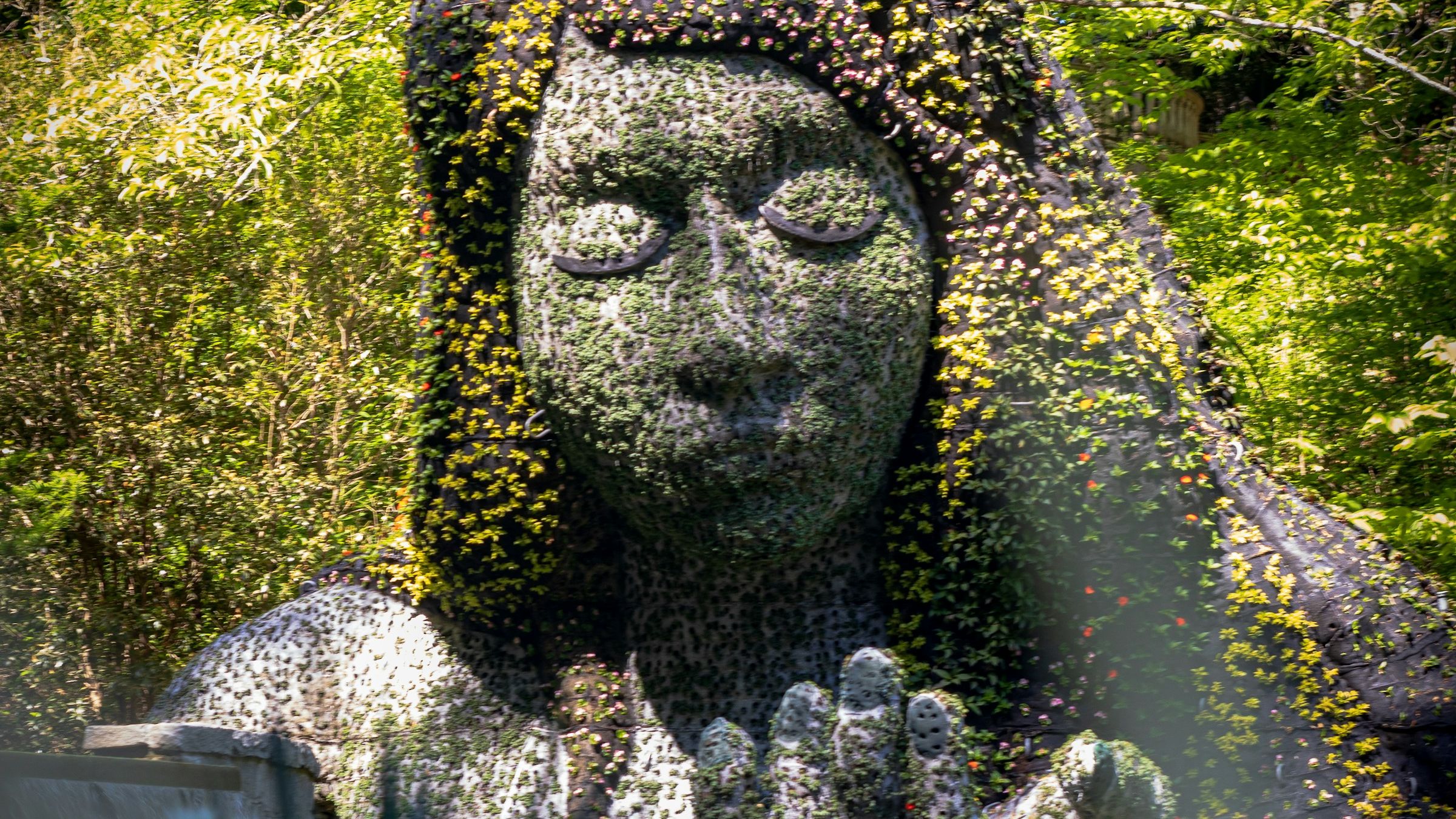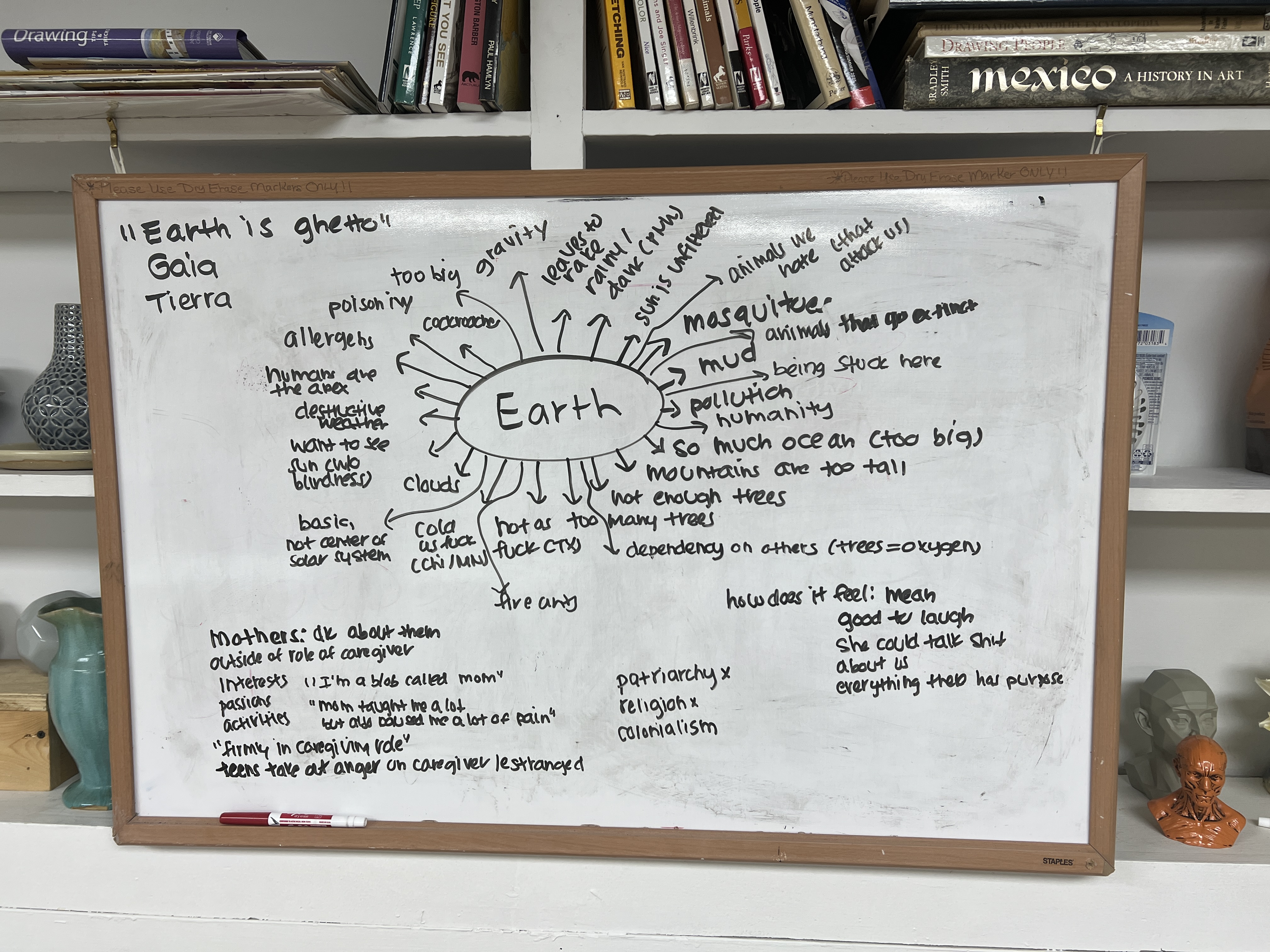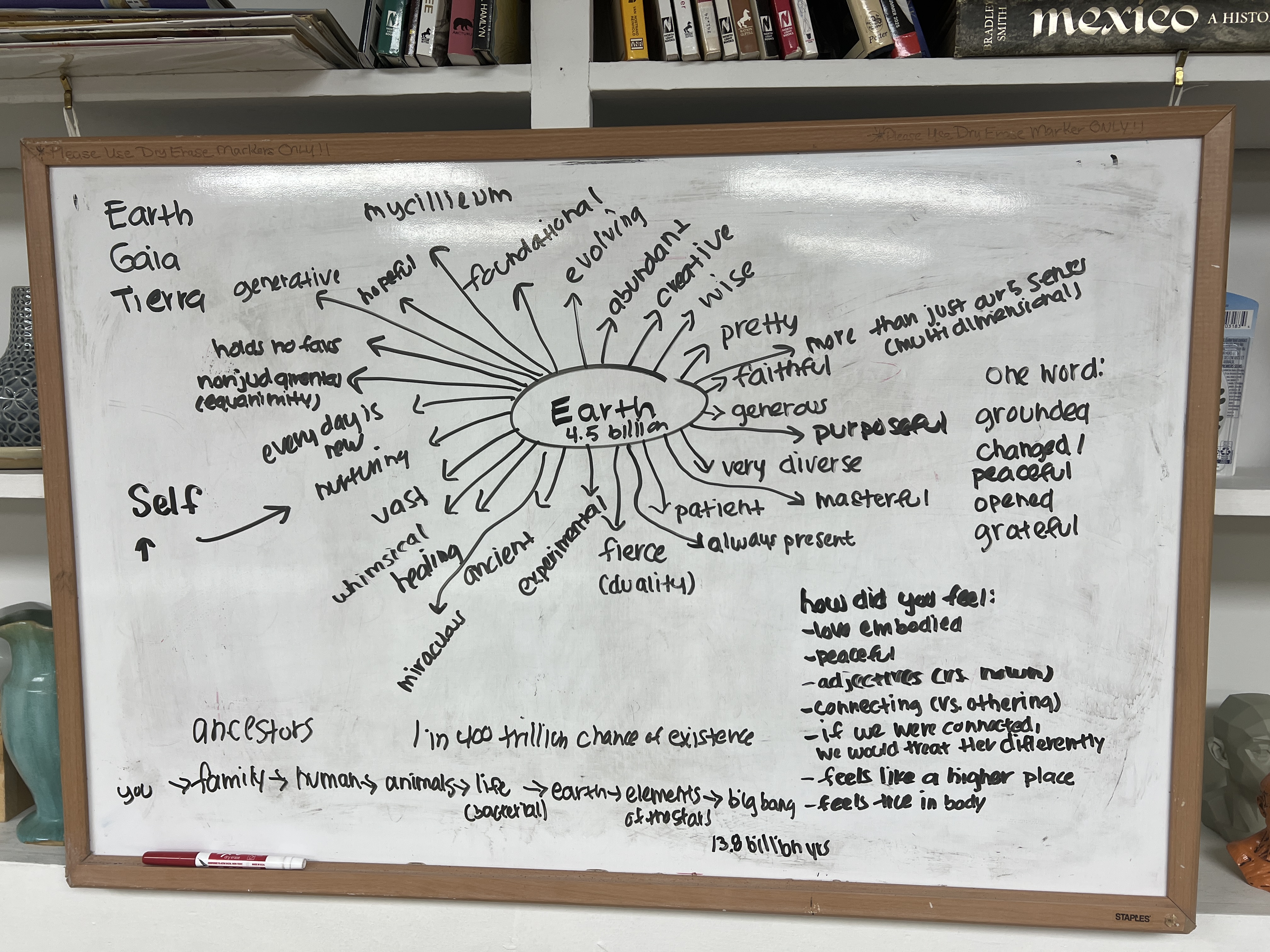What Earth Teaches Us About Creative Liberation: An Intimate Classroom
Oct 27, 2025
I stood in front of a whiteboard at the Creative Arts Center, marker in hand, with only three students in the room.
My ego had feelings about this.
After keynoting for hundreds, after building frameworks that thousands have engaged with online, here I was facilitating an intimate workshop on creative liberation through the four elements—and only three people had signed up. When I first started teaching and facilitating, I wanted bigger numbers.
The more people in the room, the better the validation felt.
At the end of class, my students thanked me for continuing to hold the space despite the small enrollment. I was honest with them: it was deflating to my ego, but filling to my soul.
Teaching three people allows me to practice deep connection with every student.
I can witness each person's transformation in real time, adjust to their energy, hold space for what's emerging rather than what I planned.
I'm teaching this Creative Liberation class in preparation for my inaugural retreat, Alma Soberana, in Samaná, Dominican Republic. Unlike my previous Creative Awakening built on exploring the chakras and creativity, this class was explicit about Creative Liberation and the four elements as the lessons.
One of my students—taking this class for the third time—is an evangelist for my work, yet hasn't been able to convince any of her friends to join despite their expressed excitement. This reveals an uncomfortable truth: many people say they want to be creatively liberated, but fewer are willing to actually do it.
The other two students were older white women, both mothers. One is also a grandmother.
Both are trying to recover their sense of self outside of being caregivers, feeling underappreciated and distant from who they are beyond "mom." One felt distant from her creativity, sensing an urge to express that she couldn't quite access. The other was called specifically by the elemental aspect of the work.
What unfolded in that room wasn't just a class—it was a ritual disguised as pedagogy, a circle of remembering where I midwifed these women back into relationship with the most ancient mother of all.
What We Hate About Earth (and the Feminine We've Been Taught to Reject)
I started with what I call a web exercise on the whiteboard.
The first assignment: talk shit about Earth. Say everything you hate about this planet.
The room came alive with complaints. Mosquitoes. Certain animals that can attack us. Humanity itself. Weather extremes. Mountains too tall. Oceans too big. Mud. Poison ivy. Allergies. Cockroaches. Pollution. Being stuck here. Gravity that's too heavy. Not enough trees. Too many trees. The claustrophobia of being enclosed on one planet. The dependency on others for survival—particularly trees for oxygen.
I then introduced another layer: beneath these surface complaints lie the domination systems—patriarchy, religion, colonialism—that have systematically disconnected us from the feminine and the provisions we receive from Earth.
I asked them: How does it feel to talk about Earth this way? Some found it cathartic. Others felt mean. The energy was raw, unfiltered—the shadow side of our relationship with the planet that gave us life.
Then I made the connection explicit: How have you been witnessed as a mother? How do you witness others as mothers? Because this is exactly how we've been conditioned to speak about the feminine—the one who provides endlessly, who we depend on completely, who we take for granted and resent for her demands on us.
We hate Earth the way colonialism, patriarchy, and religion taught us to hate the feminine. We resent our need to eat, sleep, excrete. We're annoyed by allergens and insects and weather we can't control. We want transcendence without embodiment, spirit without matter, freedom without interdependence.
The hatred of Earth is hatred of our own embodiment. It's the colonized mind rejecting the very container that makes our existence possible, seeing our planetary home as a prison rather than a sanctuary.
It's the same disgust projected onto mothers—those who carried us, fed us, cleaned up our messes, kept us alive when we were most vulnerable.
We take the labor of care for granted and call it "ghetto" when it doesn't meet our aestheticized expectations.
By the end, the room felt heavy with recognition.
What We Revere About Earth (and the Higher Self Within Us)
Then I asked them to flip the inquiry: What do you love about Earth? What do you revere?
The energy in the room completely transformed. Their tone shifted—softer, more reverential. Words poured out: generous, abundant, all-accepting, kind, diverse, faithful, patient, always present, grounded, miraculous, evolutionary, creative, wise, purposeful, masterful, ancient, healing, experimental, fierce in duality.
Someone noted that Earth holds no fear, that she's not the center of the solar system yet remains essential. Earth has mycelium—the underground network connecting all life.
I added that Earth provides marijuana, recognizing her generous provision of medicine and pleasure, and connected this to how our ancestors witnessed the same moon, the same celestial sky we see tonight.
Earth is vast yet intimate, whimsical yet purposeful.
I shared the timeline: "You are a one in 400 trillion chance of existence." The improbability of our being here, on this rare planet that sustains life, in bodies that can think and feel and create.
I let them sit with these words for a moment. Then I took the web and started rewriting their adjectives in first person: I am generous. I am abundant. I am miraculous. I am evolution. I am always present.
"These are all descriptors that exist within you," I told them. "Your higher self. You couldn't recognize these qualities in Earth if they didn't already live inside you. Everything you revere about Earth is also asking to be revered in yourself."
The room went quiet. Something landed. Students reported feeling embodied, peaceful, connected—like being in a higher place. They could feel themselves beneath the criticism, beneath the role of mother or caregiver or the one who provides. They could feel their own generosity, their own patience, their own evolutionary nature. I myself, felt grateful that I got to do this work.
Earth's Sacred Significance: What the Planet Teaches Us About Liberation
After students photographed the whiteboard, we went outside. A storm was coming. The leaves were dancing. We stood under the trees and breathed together, witnessing the elemental synchronicity—that the very planet we'd been discussing was now moving through us, reminding us we are not separate from her.
My reverence for Mother Earth comes from astrophysics mixed with separate studies of colonialism and digging into my own history as a mixed-race Dominican Republic-born woman.
Earth is 4.5 billion years old—ancient beyond our comprehension, yet still evolving.
She's the only known planet that sustains life, a rare condition in a vast universe.
We are each a one in 400 trillion chance of existence.
Indigenous cosmologies have always understood what Western science is only beginning to acknowledge: Earth is not a resource to be extracted from, but a living interconnected system of which we are one part.
Mycelium networks demonstrate that forests are not collections of individual trees competing for resources, but collaborative communities sharing nutrients and information underground.
The relationship between how we treat Earth and how we've treated Black and Brown bodies follows the same logic—both exploited, both essential, both expected to endure endless extraction without complaint.
Scholars like Octavia Butler in Parable of the Sower and Alexis Pauline Gumbs in Undrowned: Black Feminist Lessons from Marine Mammals have explored these parallels.
The colonizer's mindset that views Earth as property to be dominated is the same mindset that justified slavery and continues to fuel environmental racism.
One of the deepest wounds of colonization is disconnection from Mother Earth.
When we reclaim our connection to Earth, we're engaging in decolonial practice. We're remembering that we are not separate from nature but expressions of it. Our creativity isn't about transcending our earthly limitations—it's about honoring them as the very conditions that make creation possible.
Earth teaches us that generative power comes from being grounded, that evolution requires patience, that diversity creates resilience, and that being present—always present, like Earth rotating through day and night, season after season—is itself a revolutionary practice.
Reflection for You
Take a moment with these questions:
- What do you hate about being embodied on Earth? What physical limitations, dependencies, or "inconveniences" of having a body do you resent most? How might these resentments mirror colonized thinking about the feminine and about creation itself?
- What qualities do you revere in Earth? How might those same qualities be asking to be more fully embodied in your own life and creative practice? Try rewriting them in first person: "I am generous. I am patient. I am always present."
- How does your relationship to your own body mirror your relationship to the planet? Where do you practice extraction versus reciprocity, domination versus collaboration, scarcity versus abundance?
- If you're a one in 400 trillion chance of existence, what does that sacred improbability ask of you? What expression is wanting to move through you that can only happen because you are here, now, in this body, on this Earth?
Assignment: Write a letter to Earth. Thank her for what she's given you. Apologize for what you've taken without reciprocity. Ask her what she needs from you. Listen for her response in the wind, the soil, the rhythm of your own breath.
For those called to explore this work more deeply: Join me at Alma Soberana, a sovereign soul retreat in Samaná, Dominican Republic, where we'll journey through all four elements—Earth, Water, Fire, and Air—to reclaim creative liberation as embodied practice. We'll explore what it means to be grounded while reaching for the stars, to honor our earth-bound existence as the sacred gift it is.
Our next element is Water, where we pick back up on November 7th (we're breaking for Halloween) to explore the integration of feminine (flow) and masculine (containment) energies.
In closing, teaching three students in an intimate classroom has taught me what keynoting to hundreds never could—that transformation doesn't require scale, it requires presence.
That creative liberation isn't about transcending Earth, but about finally coming home to Her.
That ritual can be disguised as pedagogy, and remembering can look like a simple whiteboard exercise followed by breathing under stormy trees.
What I facilitated wasn't just a class.
It was a circle of remembering, a midwifing back into relationship with the most ancient mother of all.
And in teaching them to remember Earth, I remembered something essential about my own work: I am already what I teach.





